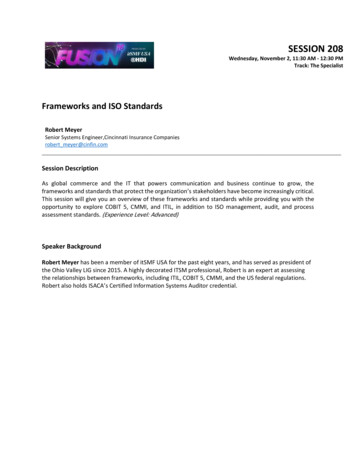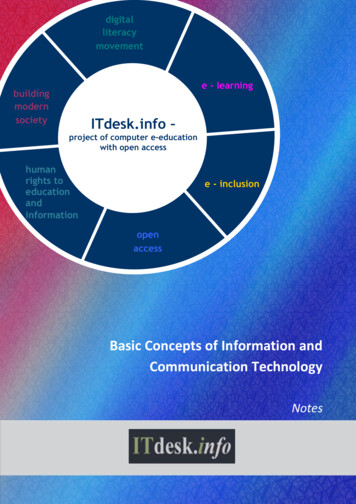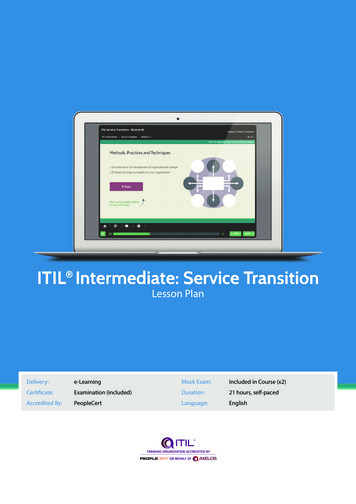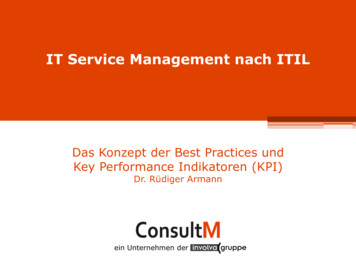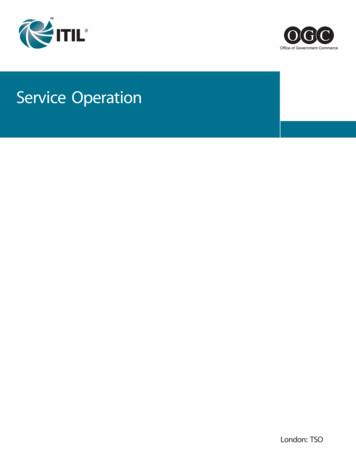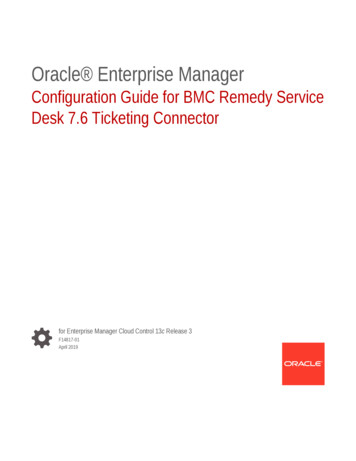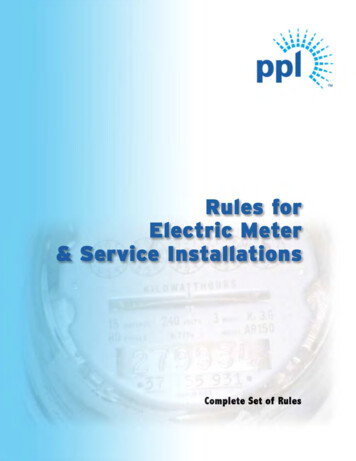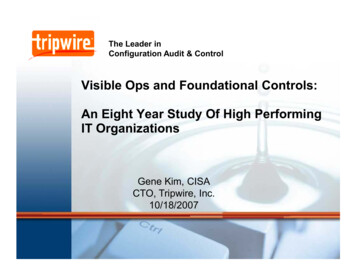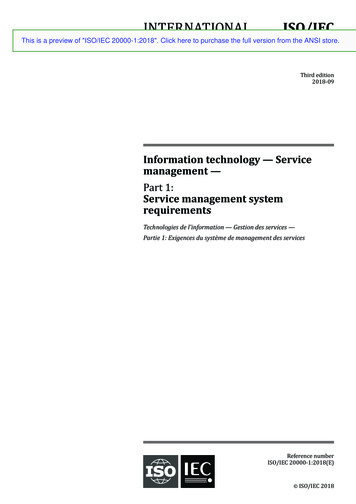
Transcription
ISO/IECINTERNATIONALThis is a preview of "ISO/IEC 20000-1:2018". Click here to purchase the full version from the ANSI store.STANDARD20000-1Third edition2018-09Information technology — Servicemanagement —Part 1:Service management systemrequirementsTechnologies de l'information — Gestion des services —Partie 1: Exigences du système de management des servicesReference numberISO/IEC 20000-1:2018(E) ISO/IEC 2018
ISO/IEC 20000-1:2018(E) This is a preview of "ISO/IEC 20000-1:2018". Click here to purchase the full version from the ANSI store.COPYRIGHT PROTECTED DOCUMENT ISO/IEC 2018All rights reserved. Unless otherwise specified, or required in the context of its implementation, no part of this publication maybe reproduced or utilized otherwise in any form or by any means, electronic or mechanical, including photocopying, or postingon the internet or an intranet, without prior written permission. Permission can be requested from either ISO at the addressbelow or ISO’s member body in the country of the requester.ISO copyright officeCP 401 Ch. de Blandonnet 8CH-1214 Vernier, GenevaPhone: 41 22 749 01 11Fax: 41 22 749 09 47Email: copyright@iso.orgWebsite: www.iso.orgPublished in Switzerlandii ISO/IEC 2018 – All rights reserved
ISO/IEC 20000-1:2018(E) This is a preview of "ISO/IEC 20000-1:2018". Click here to purchase the full version from the ANSI store.Contents PageForeword.vIntroduction. vii12345678Scope. 11.1General. 11.2Application. 1Normative references. 2Terms and definitions. 23.1Terms specific to management system standards. 23.2Terms specific to service management. 6Context of the organization.104.1Understanding the organization and its context. 104.2Understanding the needs and expectations of interested parties. 104.3Determining the scope of the service management system. 104.4Service management system. 10Leadership. 105.1Leadership and commitment. 105.2Policy. 115.2.1Establishing the service management policy. 115.2.2Communicating the service management policy. 115.3Organizational roles, responsibilities and authorities. 11Planning. 126.1Actions to address risks and opportunities. 126.2Service management objectives and planning to achieve them. 126.2.1Establish objectives. 126.2.2Plan to achieve objectives. 136.3Plan the service management system. 13Support of the service management system.137.1Resources. 137.2Competence. 147.3Awareness. 147.4Communication. 147.5Documented information. 147.5.1General. 147.5.2Creating and updating documented information. 157.5.3Control of documented information. 157.5.4Service management system documented information. 157.6Knowledge. 16Operation of the service management system.168.1Operational planning and control. 168.2Service portfolio. 168.2.1Service delivery. 168.2.2Plan the services. 168.2.3Control of parties involved in the service lifecycle. 178.2.4Service catalogue management. 178.2.5Asset management. 178.2.6Configuration management. 188.3Relationship and agreement. 188.3.1General. 188.3.2Business relationship management. 198.3.3Service level management. 198.3.4Supplier management. 20 ISO/IEC 2018 – All rights reserved iii
ISO/IEC 20000-1:2018(E) This is a preview of "ISO/IEC 20000-1:2018". Click here to purchase the full version from the ANSI store.8.48.58.68.7910Supply and demand. 218.4.1Budgeting and accounting for services. 218.4.2Demand management. 218.4.3Capacity management. 21Service design, build and transition. 218.5.1Change management. 218.5.2Service design and transition. 238.5.3Release and deployment management. 24Resolution and fulfilment. 248.6.1Incident management. 248.6.2Service request management. 258.6.3Problem management. 25Service assurance. 258.7.1Service availability management. 258.7.2Service continuity management. 268.7.3Information security management. 26Performance evaluation.279.1Monitoring, measurement, analysis and evaluation. 279.2Internal audit. 279.3Management review. 289.4Service reporting. 29Improvement.2910.1 Nonconformity and corrective action. 2910.2 Continual improvement. 29Bibliography. 31iv ISO/IEC 2018 – All rights reserved
ISO/IEC 20000-1:2018(E) This is a preview of "ISO/IEC 20000-1:2018". Click here to purchase the full version from the ANSI store.ForewordISO (the International Organization for Standardization) and IEC (the International ElectrotechnicalCommission) form the specialized system for worldwide standardization. National bodies that aremembers of ISO or IEC participate in the development of International Standards through technicalcommittees established by the respective organization to deal with particular fields of technicalactivity. ISO and IEC technical committees collaborate in fields of mutual interest. Other internationalorganizations, governmental and non-governmental, in liaison with ISO and IEC, also take part in thework. In the field of information technology, ISO and IEC have established a joint technical committee,ISO/IEC JTC 1.The procedures used to develop this document and those intended for its further maintenance aredescribed in the ISO/IEC Directives, Part 1. In particular the different approval criteria needed forthe different types of document should be noted. This document was drafted in accordance with theeditorial rules of the ISO/IEC Directives, Part 2 (see www .iso .org/directives).Attention is drawn to the possibility that some of the elements of this document may be the subjectof patent rights. ISO and IEC shall not be held responsible for identifying any or all such patentrights. Details of any patent rights identified during the development of the document will be in theIntroduction and/or on the ISO list of patent declarations received (see www .iso .org/patents).Any trade name used in this document is information given for the convenience of users and does notconstitute an endorsement.For an explanation on the voluntary nature of standards, the meaning of ISO specific terms andexpressions related to conformity assessment, as well as information about ISO's adherence to theWorld Trade Organization (WTO) principles in the Technical Barriers to Trade (TBT) see the followingURL: www .iso .org/iso/foreword .html.This document was prepared by ISO/IEC JTC 1, Information technology, SC 40, IT Service Managementand IT Governance.This third edition cancels and replaces the second edition (ISO/IEC 20000-1:2011) which has beentechnically revised.The main changes compared to the previous edition are as follows.a)Restructured into the high level structure used for all management system standards (from AnnexSL of the Consolidated ISO Supplement to the ISO/IEC Directives Part 1). This has introduced newcommon requirements for context of the organization, planning to achieve objectives and actions toaddress risks and opportunities. There are some common requirements that have updated previousrequirements, for example, documented information, resources, competence and awareness.b) Taken into account the growing trends in service management including topics such as thecommoditisation of services, the management of multiple suppliers by an internal or externalservice integrator and the need to determine value of services for customers.c)Removed some of the detail to concentrate on what to do and allow organizations the freedom ofhow to meet the requirements.e)Separated out clauses that were previously combined for incident management, service requestmanagement, service continuity management, service availability management, service levelmanagement, service catalogue management, capacity management, demand management.d) Included new features such as the addition of requirements about knowledge and planning theservices.f)Renamed “Governance of processes operated by other parties” to “Control of parties involved in theservice lifecycle” and updated the requirements to include services and service components as wellas processes. Clarified that the organization cannot demonstrate conformity to the requirements ISO/IEC 2018 – All rights reserved v
ISO/IEC 20000-1:2018(E) This is a preview of "ISO/IEC 20000-1:2018". Click here to purchase the full version from the ANSI store.specified in this document if other parties are used to provide or operate all services, servicecomponents or processes within the scope of the service management system (SMS).g) Separated Clause 3 (Terms and definitions) into sub-clauses for management system terms andservice management terms. There are many changes to definitions. The key changes include:1) some new terms have been added for Annex SL, e.g. “objective”, “policy”, and some have beenadded specifically for service management, e.g. “asset”, “user”;2) the term “service provider” has been replaced by “organization” to fit with the Annex SLcommon text;3) the term “internal group” has been replaced by “internal supplier” and the term “supplier” hasbeen replaced by “external supplier”;4) the definition of “information security” has been aligned with ISO/IEC 27000. Subsequentlythe term “availability” has been replaced by “service availability” to differentiate from theterm “availability” which is now used in the revised definition of “information security”.h) Minimised the required documented information leaving only key documents such as the servicemanagement plan. Other documented information changes include:1) removed requirement for documented capacity plan and replaced with requirement to plancapacity;2) removed requirement for documented availability plan and replaced with requirement todocument service availability requirements and targets;3) removed requirement for a configuration management database and replaced withrequirements for configuration information;4) removed requirement for a release policy and replaced with a requirement to define releasetypes and frequency;i)j)5) removed requirement for a continual improvement policy and replaced with a requirement todetermine evaluation criteria for opportunities for improvement.Updated and renumbered Figures 2 and 3 to Figures 1 and 2. Removed Figure 1 and references toPlan-Do-Check-Act as this is not specifically used in Annex SL because many improvement methodscan be used with management system standards.Moved detailed reporting requirements from the service reporting clause into the clauses wherethe reports are likely to be produced.A list of all parts in the ISO/IEC 20000 series can be found on the ISO website.Any feedback or questions on this document should be directed to the user’s national standards body. Acomplete listing of these bodies can be found at www .iso .org/members .html.vi ISO/IEC 2018 – All rights reserved
ISO/IEC 20000-1:2018(E) This is a preview of "ISO/IEC 20000-1:2018". Click here to purchase the full version from the ANSI store.IntroductionThis document has been prepared to specify requirements for establishing, implementing, maintainingand continually improving a service management system (SMS). An SMS supports the management ofthe service lifecycle, including the planning, design, transition, delivery and improvement of services,which meet agreed requirements and deliver value for customers, users and the organization deliveringthe services.The adoption of an SMS is a strategic decision for an organization and is influenced by the organization’sobjectives, the governing body, other parties involved in the service lifecycle and the need for effectiveand resilient services.Implementation and operation of an SMS provides ongoing visibility, control of services and continualimprovement, leading to greater effectiveness and efficiency. Improvement for service managementapplies to the SMS and the services.This document is intentionally independent of specific guidance. The organization can use a combinationof generally accepted frameworks and its own experience. The requirements specified in this documentalign with commonly used improvement methodologies. Appropriate tools for service management canbe used to support the SMS.ISO/IEC 20000-2 provides guidance on the application of service management systems includingexamples of how to meet the requirements specified in this document. ISO/IEC 20000-10 providesinformation on all of the parts of the ISO/IEC 20000 series, benefits, misperceptions and other relatedstandards. ISO/IEC 20000-10 lists the terms and definitions included in this document in addition toterms not used in this document but used in other parts of the ISO/IEC 20000 series.The clause structure (i.e. clause sequence), terms in 3.1 and many of the requirements are taken fromAnnex SL of the Consolidated ISO Supplement to the ISO/IEC Directives Part 1, known as the commonhigh level structure (HLS) for management system standards. The adoption of the HLS enables anorganization to align or integrate multiple management system standards. For example, an SMScan be integrated with a quality management system based on ISO 9001 or an information securitymanagement system based on ISO/IEC 27001.Figure 1 illustrates an SMS showing the clause content of this document. It does not represent astructural hierarchy, sequence or authority levels. There is no requirement in this document for itsstructure to be applied to an organization’s SMS. There is no requirement for the terms used by anorganization to be replaced by the terms used in this document. Organizations can choose to use termsthat suit their operations.The structure of clauses is intended to provide a coherent presentation of requirements, rather thana model for documenting an organization’s policies, objectives and processes. Each organization canchoose how to combine the requirements into processes. The relationship between each organizationand its customers, users and other interested parties influences how the processes are implemented.However, an SMS as designed by an organization, cannot exclude any of the requirements specified inthis document. ISO/IEC 2018 – All rights reserved vii
ISO/IEC 20000-1:2018(E) This is a preview of "ISO/IEC 20000-1:2018". Click here to purchase the full version from the ANSI store.Figure 1 — Service management systemviii ISO/IEC 2018 – All rights reserved
ISO/IEC 20000-1:2018(E) Foreword ISO (the International Organization for Standardization) and IEC (the International Electrotechnical Commission) form the specialized system for worldwide standardization. National bodies that are members of ISO or IEC participate in the development of International Standards through technicalFile Size: 1MB


